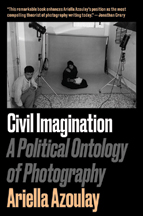 |
Ariella Azoulay. Civil Imagination: A Political Ontology of Photography. London and New York: Verso Books, 2012.
In Civil Imagination, Ariella Azoulay says that in the context of a regime-made disaster the regime, its citizens and those that it subjugates are all part of the same disaster. This is a condition that requires the emergence of a civil and political imagination to think a way out of the conditions of catastrophe. She argues that photography, precisely because of the dialogical space that it offers, provides such a platform. Azoulay wrote this in the context of Israel-Palestine, but it offers a way to rethink a number of spaces of political conflict. All too often we are caught in the platitudes of neoliberal technophilia, urged to believe that social media produces visibility, connection and thus democracy in places like Iran or Egypt. But Azoulay shows us that photography is about more than just liking or sharing. It is about the labor of discourse and thus, the creation of a public sphere. |